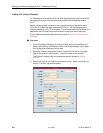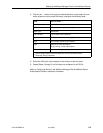
Setting Up NetScout Manager Plus for FrameSaver Devices
8-12
9123-A2-GB20-10
July 2000
Installing the User-Defined History Files
Once the user-defined history files have been created, the files need to be
installed. History files are installed from the command-line prompt in NetScout
Manager Plus. Should the FrameSaver unit be reset, these files will need to be
reinstalled. The command used to install a new user history table is located in
$NSHOME/bin.
CAUTION:
Do not use user_history_table_1 or 2. UserHistory1 and UserHistory2
are the default user history files used to keep FLEX and SLV data for
reports. Editing either of these files will destroy FLEX and SLV reporting
capability.
" Procedure
1. Type dvuhist -f
agentname user_history_table_number
config
number_of_buckets interval download_file
.udh to load user-defined history
files for the frame relay link.
Example:
dvuhist -f Dallas51 3 config 30 60 Dallas51k.udh
The interval must be entered in seconds.
2. Type dvuhist -f
“agentname DLCI_number
”
user_history_table_number
config
number_of_buckets interval download_file
.udh to load user-defined
history files for a specific DLCI.
Example:
dvuhist -f “Dallas51 301” 3 config 30 60 Dallas301.udh
The same user history table number can be used for both the link and DLCI.
For these examples, user history table number 3 will appear as UserHistory3
on the History List.
See Step 5 in
Monitoring a DLCI’s History Data
to verify that the user-defined
history files have been loaded.
Refer to
Installing .UDH Files
in
Using Custom History
of the
NetScout Manager
Plus User Guide
for additional information.


















